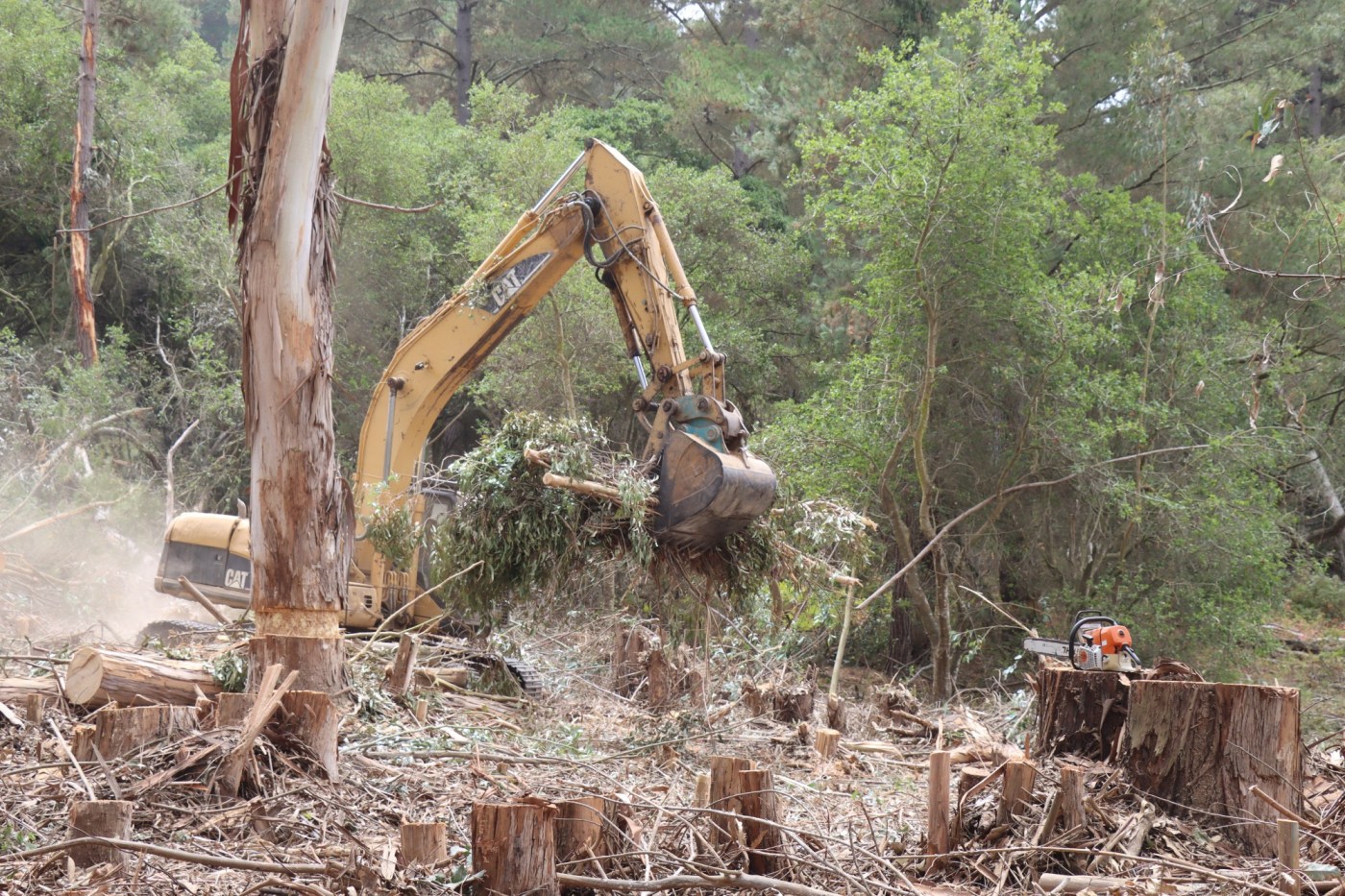MOSS LANDING >> A suite of local climate change adaptation projects launched this month thanks to a recent infusion of $71.1 million in federal funds.
Related Articles
Letters: Fremont mayor | Measure J | Housing crisis | Squandering sacrifice | Disdain for institutions | Overwhelming defeat
Letters: Prop. 4 | Taxpayers’ burden | Children’s future | U.S. first | Tragic legacy | Hope and faith
Trump can tap the brakes on the EV revolution, but not stop it
Hydrogen startup Verdagy opens San Jose plant at risky moment
How full are California’s reservoirs heading into the winter rainy season?
The National Oceanic and Atmospheric Administration awarded the monumental grant — part of the Climate Resilience Regional Challenge funded by the Inflation Reduction Act — for wildfire and flood risk prevention, regional collaboration and workforce development across the Monterey Bay area.
Locally, the Esselen Tribe will lead prescribed burns, Elkhorn Slough Foundation will expand eucalyptus removal and other groups will reduce vegetation fuels on the Mitteldorf and Santa Lucia Preserves. Several collaborators will also spearhead flood prevention efforts around the Salinas River, Carmel River and the Elkhorn Slough. To engage youth in the funded fire and flood projects, Cal State Monterey Bay received $2 million for paid undergraduate internships, teacher assistant positions and scholarships.
Cal State Monterey Bay. (David Kellogg — Monterey Herald)
“We’re thrilled,” said Gerick Bergsma, assistant professor of marine science and faculty advisor for the newly expanded science internship program. “We pride ourselves in experiential learning, but a lot of students are limited by finances. Being able to fund internships and professional experience is fantastic and allows us to be a lot more equitable.”
These educational opportunities, beginning as soon as next spring, will focus on giving students the technical skills necessary to contribute to the funded adaptation work. Watsonville Wetlands Watch, Hartnell College and the University of California, Santa Cruz, also received monies for workforce training.
Local officials and environmental leaders celebrated the award of the highly competitive federal funds to California Marine Sanctuary Foundation — the lead applicant — and its many collaborators recently in Moss Landing. After being notified this summer of the five-year grant, around 30 regional partners kicked off their funded work on Oct. 1.
“The Monterey Bay region will become a model for how communities can adapt to climate change by empowering local talents and fostering the skills necessary for future resilience projects,” Robert Mazurek, the foundation’s executive director, said at the launch event. “This project is not just about protecting our coastline and watersheds. It is about protecting the heart of our communities and ensuring a future where every resident can thrive despite a changing climate.”
The grant is also one of the largest for a nonprofit in California’s history, he noted.
Across Monterey and Santa Cruz Counties, the winning projects focus on low-lying, disadvantaged communities that face the threat of wildfires and of flooding from sea level rise and from major local rivers – San Lorenzo, Pajaro, Salinas and Carmel. Flood risk reduction is the largest piece of the grant, with over $40 million awarded to 10 projects. Five wildfire reduction projects together received nearly $11 million. Another significant chunk of the grant, around $9 million, went to existing collaboratives plus to the establishment of a new adaptation revolving fund and Monterey Bay Climate Adaptation Action Network. The network, which will coordinate implementation and planning, has two liaisons devoted to collaboration with the eight local tribes and others focused on engagement with marginalized communities.
Nearly $7 million is earmarked for workforce development. Mazurek emphasized that, over five years, the funds will create 15 full-time jobs, 270 part-time jobs and over 350 paid internships.
“For me, personally having read a lot of the proposals, their workforce development is inspiring,” Becky Smyth, who is the West Coast director of NOAA’s coastal management office, told The Herald. “It really is about giving all the workforce, from the people doing the work in wetlands to the students who will go into academia, the ability to be part of the solution.”
The notable collaboration and breadth of the programs also stood out to Smyth.
With NOAA funds, the Esselen Tribe plans to conduct burns on Basin Ranch, much like the one pictured above. (Hannah Hagemann – Santa Cruz Sentinel archive)
With NOAA funds, the Esselen Tribe plans to conduct burns on Basin Ranch. The tribe — in partnership with the Resource Conservation District of Monterey County, Central Coast Prescribed Burn Association and Big Sur Land Trust — is working to build wildfire resistance on the land through fire, a cultural practice, while also protecting culturally significant flora. Fires will also burn at Glen Deven Ranch.
In northern Monterey County, Elkhorn Slough Foundation and the Monterey conservation district will buffer 700 homes in Las Lomas, Elkhorn and Prunedale by removing about 40 acres of invasive, blue gum eucalyptus trees. Eucalyptus can easily torch, sending flying embers miles to light spot fires. The partners will fell trees, treat the stumps so they don’t regrow and process the wood into biochar. The foundation began eucalyptus removal in 2018.
Separate, additional fuel load reduction projects are planned for the Santa Lucia and Mitteldorf Preserves, led by Santa Lucia Conservancy and Big Sur Land Trust respectively.
Monterey will also host significant flood risk prevention efforts. The Monterey district plans to expand its work along the Salinas River with the help of property owners, growers and municipalities across 100 miles from San Ardo to Highway 1. The property owners will do the work on the ground, while the grant funds the district’s ecological oversight. Together, they will remove invasive reeds and put in 50 acres of new secondary channels for the Salinas River to absorb high flows during storms — thus decreasing pressure on levees and reducing the risk of flooding onto nearby farmlands. A second flood reduction project, involving Coastal Conservation & Research and other partners, targets Salinas River Lagoon and old Salinas River.
Meanwhile, the Elkhorn Slough National Estuarine Research Reserve is making its first major investment in the northern portion of the estuary, the Pelican Marsh complex, to protect public access and critical transportation corridors from rising seas. The project will draw plans for future restoration.
The County of Monterey and Big Sur Land Trust is pursuing a large project to redirect flood waters from the Carmel River, which has historically inundated nearby residences, to Carmel Lagoon.
A car evacuates Paso Hondo Road as the Carmel River flood waters rise in Carmel Valley. (David Royal — Herald file)
Other essential projects take place in Santa Cruz County, including the restoration of wetlands and floodplains that could mitigate future flooding in Pajaro.
“We’re all so grateful that the community foundation was willing to take this on,” Paul Robins, who directs the Monterey conservation district, said of the California Marine Sanctuary Foundation. “This work has really inclusive, broad engagement in terms of different types of groups and communities… and also reflects the expanding collaborative of organizations that’s been exciting to see building over the past 15 years I’ve worked in Monterey County.”












